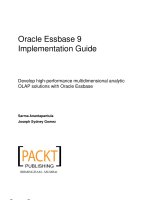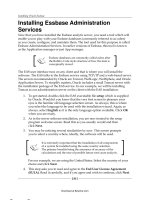Oracle Essbase 9 Implementation Guide- P2 ppsx
Bạn đang xem bản rút gọn của tài liệu. Xem và tải ngay bản đầy đủ của tài liệu tại đây (707.64 KB, 5 trang )
Acknowledgements
We met as co-workers working together to build Essbase systems for the company we
are employed by. Along the way we became more than co-workers, we became friends.
Here we are today, co-workers, friends, and now co-authors.
Hi all, this is Sarma here, rst I would like to thank my beloved Lord Sri Sathya Sai
Baba for giving me an opportunity to write this book. Huge thanks to my wonderful
wife Kalyani for being so patient with my late nights, and for her faithful support in
writing this book, without her tremendous support this book would not be possible.
Special thanks to my sweet kids Sai (8 years old) and Saranya (3 years old) for
sacricing their fun and playtime with me. Many thanks to my father and mother for
giving me sincere encouragement while writing this book. Thanks to all my special
friends who supported me while writing this book. Lastly my utmost thanks to my
dearest friend Joe Gomez for his help and cooperation during this challenging period.
Hi everyone, Joe here. Boy, that’s a tough act to follow but I’ll try. First and foremost,
I would like to thank my lovely wife Rita, my beautiful daughter Ashley and my
son Joey for putting up with me (or avoiding me), encouraging me, and supporting
me during my distracted state while I was involved in writing this book. I especially
want to thank my true friend Sarma Anantapantula for asking me if I would like to
join him on this venture because I certainly wouldn’t have thought of it on my own!
Collectively, we would like to thank James Lumsden, Acquisition Editor, without
whom we would have never written this book or very likely, any other book! Our
special thanks go to Bhupali Khule, Technical Editor, for seamlessly working with
us to complete this book and Pallavi Kachare, Technical Editor, for performing the
code reviews. Our special thanks also go to Ved Prakash Jha, Development Editor,
and Rajashree Hamine, Project Coordinator, for making sure we are on target for
the launch. We would also like to thank the entire Packt staff for all of their help and
guidance throughout the completion of this book. We would also like to thank the
reviewers for their reviews and suggestions.
Finally we really want to thank all of you who purchased this book. We have put
every bit of our Essbase knowledge and experience into this book so you can avoid
some of the inevitable pitfalls of learning a new piece of technology. We hope you
feel that you made a worthwhile purchase. We certainly feel you did!
This material is copyright and is licensed for the sole use by Paul Corcorran on 5th July 2009
8601 ave. p #1, , lubbock, , 79423
Download at Boykma.Com
Table of Contents
Preface 1
Chapter 1: Installing Oracle Essbase 13
Installing the Essbase analytic server 13
Installing Essbase Administration Services 20
Starting the EAS 23
Installing the Essbase Add-in for Microsoft Excel 25
A typical network setup 28
Summary 29
Chapter 2: Essbase Data and Design Considerations 31
Introduction to OLAP 31
Determining the data requirements 32
Determine data storage options 35
Types of Essbase applications 38
Aggregate Storage Option (ASO) 39
Block Storage Option (BSO) 40
Unicode and Non-Unicode applications 42
Creating your rst Essbase application 43
Essbase Application Properties 45
Startup section 46
Security 46
Minimum access level 46
Types of Essbase databases 47
The normal (non-currency) database 47
Essbase currency database 47
Database components 47
The database outline 48
Linked Reporting Objects 48
Partitions 48
This material is copyright and is licensed for the sole use by Paul Corcorran on 5th July 2009
8601 ave. p #1, , lubbock, , 79423
Download at Boykma.Com
Table of Contents
[ ii ]
Calculation scripts 49
Report scripts 50
Database load rules les 50
Allowing duplicate member names 50
Create your rst Essbase database 51
General tab 53
Dimensions tab 54
Statistics tab 54
Caches tab 55
Transactions tab 56
Storage tab 56
Currency tab 57
Modications tab 58
Types of Essbase users 58
Summary 61
Chapter 3: Building the Essbase Outline 63
Before we begin 63
The Essbase outline—the foundation 64
Dimensions and members 64
Outline member descriptors 66
Generations and Levels 68
Generation 68
Level 69
Types of dimensions 70
Standard dimension 70
The Account dimension type 70
The Time dimension type 70
The Country dimension type 70
No dimension type or general dimension 71
The Currency Partition dimension type 71
The Attribute dimension 72
Dense and Sparse dimensions 72
Build your rst outline 75
Member properties 78
Member consolidations 78
Valid consolidation operators 78
Member storage 80
Member formulas 82
Member alias 84
Alias table 86
Build your rst data rules le 86
This material is copyright and is licensed for the sole use by Paul Corcorran on 5th July 2009
8601 ave. p #1, , lubbock, , 79423
Download at Boykma.Com
Table of Contents
[ iii ]
Step 1: Start the Data Prep Editor 87
Step 2: Associate the Dimension Build Rules le 88
Step 3: Open data load le or the SQL data source le 89
Step 4: Set the Data Source Properties 91
Step 5: Set the View to Dimension build elds 92
Step 6: Select Dimension build method 93
Generation reference 93
Level reference 94
Parent-child reference 94
Step 7: Format le 98
Step 8: Associate elds with dimensions 101
Step 9: Validate the Dimension Build rules le 103
Update your outline using a rules le 104
Update your outline using the EAS Outline Editor 104
Update using MaxL Shell 106
Executing MaxL from EAS editor 106
Executing MaxL from command prompt 108
Attribute dimensions 109
User Dened Attributes (UDA) 111
Dynamic Time Series 113
Shared members 115
Summary 116
Chapter 4: Loading Data into Essbase 119
Make your data Essbase-friendly 120
Essbase-friendly thoughts 120
Essbase-friendly example 121
Types of data sources 123
Type of data 123
Types of les used for data loads 124
Relational databases 125
Data load methods 125
Data le freeform (no load rule) 125
Essbase export and import (no load rule) 126
Structured data load (load rule used) 130
Microsoft Excel Lock and Send (no load rule) 130
Building your rst data load rules le 131
Step 1: Starting the Data Prep Editor 132
Step 2: Associating the data load rules le 132
Step 3: Opening data load le or the SQL data source le 133
Step 4: Setting the View to Data Load Fields 135
Step 5: Setting the Data Source Properties 135
This material is copyright and is licensed for the sole use by Paul Corcorran on 5th July 2009
8601 ave. p #1, , lubbock, , 79423
Download at Boykma.Com
Table of Contents
[ iv ]
Step 6: Updating the Data Load Settings 136
Step 7: Setting the Data Load Values 136
Clearing Data Combinations 139
Header Denition 140
Step 8: Associating elds with Data Load Properties 141
Global properties 142
Data Load Properties 142
Step 9: Validating the data load rules le 145
Step 10: Saving the data load rules le 146
Loading data into your database 147
Using the EAS to load data into your Essbase cube 147
Loading data using MaxL 151
Data Load vs. Dimension Build 152
Summary 153
Chapter 5: Calculating your Essbase Cube 155
Calculating your database 156
The Essbase calculation script 156
Essbase outline member formula 158
Calculation types explained 159
Calculation Scripts 160
Stored data member formula 161
Dynamic Calc and Dynamic Calc and Store 161
Essbase calculation terminology 162
Default database calculation script 163
Calc All 165
Calculate/Aggregate dimension 166
Essbase Calc commands and functions 167
Data declarations 167
Control ow 168
FIX/ENDFIX 168
EXCLUDE/ENDEXCLUDE 171
Functional 173
SET command functions 173
Conditionals 176
IF/ENDIF 176
Boolean 178
Relationship functions 179
Operators 181
Member set 182
Range (Financial) 183
Forecasting 184
Statistical 185
This material is copyright and is licensed for the sole use by Paul Corcorran on 5th July 2009
8601 ave. p #1, , lubbock, , 79423
Download at Boykma.Com









